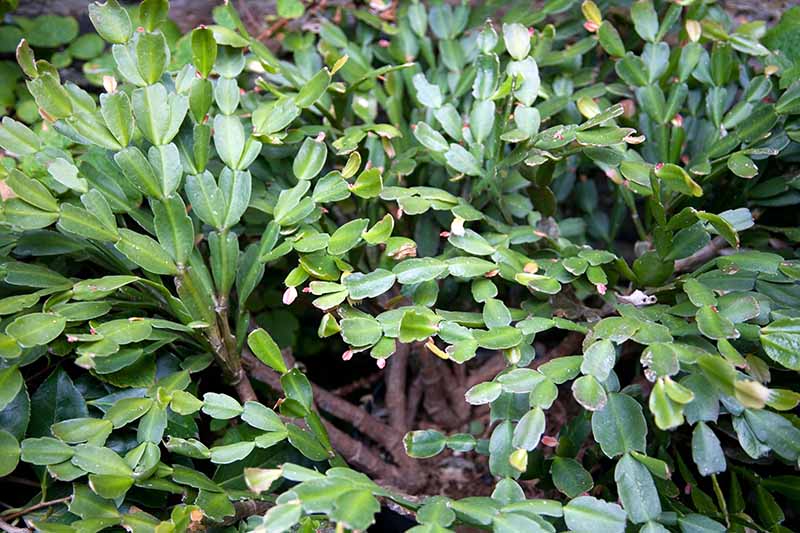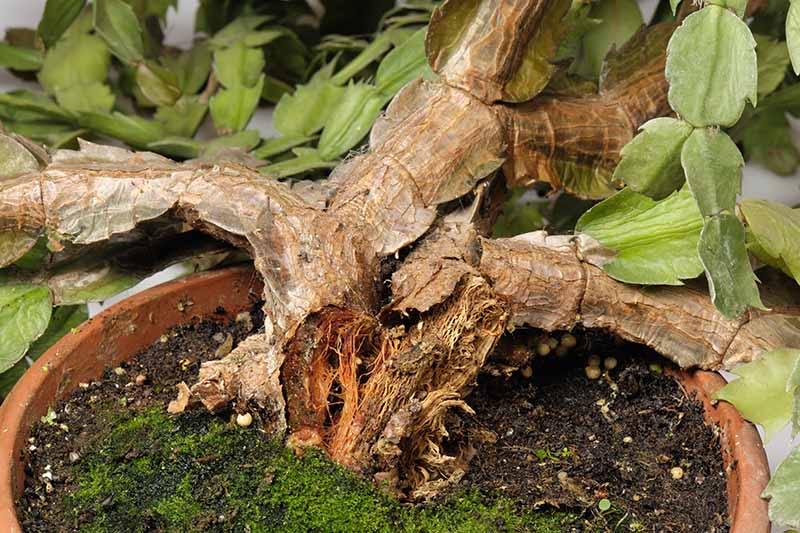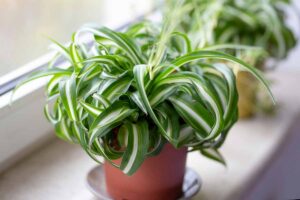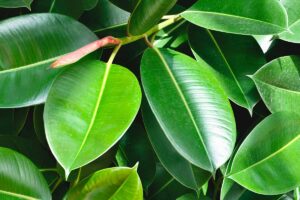The Christmas cactus, Schlumbergera spp., is not a desert cactus.
It grows instead in the moist understories of South American rainforests.
As a houseplant, it’s easy to maintain in a container of well-draining, organically-rich potting medium in a location with indirect sunlight.

We link to vendors to help you find relevant products. If you buy from one of our links, we may earn a commission.
In our Christmas cactus growing guide we discuss how to cultivate this colorful houseplant in your home.
This article zeroes in on one particular characteristic: woody stems.
What You’ll Learn
Let’s get started.
Why Do Stems Become Woody?
Christmas cacti don’t have leaves. Instead, they have fleshy green segments called cladodes that join together to form stems.
With proper care, a plant may become a family heirloom, often living for 20 years or more.

In the case of an older cactus, while there may be a proliferation of green growth cascading over the side of the pot, a peek into the center of the plant is likely to reveal a forest of thick, hard brown stems.
Just like a person, when Schlumbergera grows old, there are physical changes. In a nutshell, the appearance of large woody stems is just that – a sign that yours has achieved old age.
Does old age spell trouble for your Christmas cactus? Let’s find out.
Age-Related Issues and Remedies
There is nothing inherently wrong with being an old plant, and woody tissue does not detract from its beauty.
However, if yours has grown to huge proportions, there could be problems. Two issues that may arise are: a rootbound pot and splitting stems.
We’ll explore each.
Rootbound Plant
Schlumbergera plants favor tight living quarters, so roots that are somewhat snug in the pot are not usually a problem.
However, when the roots start to peek out of the drainage hole in the bottom of the pot, it may be time to get a slightly larger container, fill it with fresh potting medium, and replant.
Roots that are tightly tangled can’t take up nutrients efficiently. And if you haven’t repotted in many years, the potting medium is likely to be depleted of essential nutrients.
So, cater to your cactus in its dotage by refreshing it.
In addition, if you see signs of malnutrition from poor nutrient uptake, like discoloration and wilting, you may want to give the plant a lift by trimming each stem by one-third before repotting.
To do this, use clean pruning shears to cut between the cladode segments.
Each cut segment will soon sprout new growth for a rejuvenated appearance, and better nutrient uptake.
Splitting Stems
Another issue with an older plant that has grown quite large is the potential for it to break apart.

Even if you don’t need to repot, you may still want to trim each stem by one-third to relieve the plant of excessive weight.
When a stem splits, it creates an open wound that is vulnerable to diseases such as bacterial soft rot, caused by Pectobacterium carotovorum, particularly in hot, humid environments.
Unfortunately, there is no effective treatment available to cure this condition.
In the event that your plant breaks or splits, and especially if the foliage and roots have become mushy or malodorous, there may still be time to act.
Unearth the cactus and rinse it thoroughly, roots and all. Use clean pruning shears to cut off all mushy foliage and rotten roots, and repot what’s left in fresh potting mix.
Do a deep pruning if necessary, cutting affected stems right back to where the brown woody part begins.
Try not to remove more than one-third of the entire plant, as it will be shocked and recovery will likely be slower.
Immediately after repotting, apply a dose of all-purpose liquid houseplant fertilizer per package instructions to jump-start recovery.
If the damage is extensive, don’t worry, because Schlumbergera are easy to propagate from soft cuttings.
To do this, simply find a few healthy green sections at least two segments long, and snip them off with clean pruning shears.
Lay them on a paper towel for a few days to heal and form a callus at the point where they were cut.
Once they have healed, place them in a well-draining container of moist, organically-rich potting medium, where they will soon grow roots and establish themselves.
Find more tips on propagation here.
The Golden Years
Whether you’re a person or a plant, getting older is just what happens when you’re in good health. Ironic, isn’t it?

Celebrate your Christmas cactus. Pamper it in its golden years. Don’t let it become severely rootbound or collapse beneath its own weight.
And rest assured that when it bursts into bloom in the holiday season, it’s not thinking of how brown its stems are, and neither should you.
Have you noticed woody stems on your Christmas cactus? Let us know in the comments section below and share your tips!
If you found this article informative and would like to learn more about Christmas cactus cultivation, check out these guides next:
- Is Christmas Cactus Toxic to Cats?
- How to Make Your Christmas Cactus Bloom
- Why Is My Christmas Cactus Turning Purple?
© Ask the Experts, LLC. ALL RIGHTS RESERVED. See our TOS for more details. Top photo via Alamy and other uncredited photos via Shutterstock.




Can you propagate from a woody stem? In water? In soil?
Hi Carole –
You can start cuttings in soil or water.
Each should have three cladodes, or “leaves.”
Let the cuttings sit for a few days to scab over before rooting.
Bury the lowest one by about one-half in sterile potting medium.
Alternatively, make a bed of gravel in a narrow container.
Fill it with about an inch of water.
Place the stem in the container, resting against the side as needed.
Both older and younger stems are equally useful for propagation, provided they are alive when you cut them.
I have the same question about the woody stem. Can I cut a piece of the stem to root it. I have my husband’s grandmother plant and it is quite large with multiple wood stems at base
Hi Barbara –
Thank you for sharing the photo of your special Christmas cactus.
Yes, you can take cuttings from the top portions of woody stems as described below. Once cut, the woody stems will sprout new growth.
my older christmas cactus has woody stems, some of which are brittle and almost appear papery. Wondering what is causing this which has led to some stems breaking?
Hi Wendy – It sounds like some of the old woody stems on your Christmas cactus are too dry. A lack of water can cause them to become brittle, papery, and prone to separating from the rest of the plant. The roots could be pot bound to the point that water isn’t penetrating as it should. In addition, old stems can become heavy enough to split from the rest of the plant, causing them to dry out and drop off. You may want to take cuttings from healthy young top growth to start one or more new plants. Then repot… Read more »
Hi! I inherited a plant from my dad, maybe fifty years old. Should I transplant? Cut back the crazy branches? Fertilize? It deserves the very best.
Hi Bonnie – What a wonderful family heirloom! The plant appears to be dry, but none of the stems look broken. I suspect it is pot-bound, and that the roots are quite crowded. Take some stem cuttings and root them in well-draining pot(s) containing organically-rich potting medium, to make one or more new plants, before making any changes to the elder cactus. Add half-strength houseplant fertilizer at the time of planting. Next, choose a new pot that drains well, and is about two inches wider in diameter than the current one. Repot the elder plant in similar fashion. Place the… Read more »
Thanks for the info. I too have a very old plant that I grew from a cutting given to me by my 7th grade teacher when I was twelve years old. That was 65 years ago! It still blooms regularly but not as many blossoms. I have given cuttings from it to many friends so hopefully it will have a legacy for generations to come.
We’re glad you enjoyed the article. How wonderful! Thanks for sharing, Alicia.
I have no idea how old this plant is …any idea or guess ? (looks similar to the picture of the broken plant in the article) I have propagated and repotted for about a year now and it’s so much healthier but has not bloomed yet…
Hi Denise –
Estimating the age of a Christmas cactus is challenging, as it can live for decades, and be rejuvenated many times with pruning. I recommend reading How to Make a Christmas Cactus Bloom for further guidance.
Hi. My woody stem broke from the weight of my Christmas Cactus leaves. What do I do to not lose this mature plant? Can I plant the base of the woody stem? Thank you.
Hi Christi –
When the weight of a plant causes breakage, you can take cuttings from the broken piece and root them to start a whole new plant. Please see our article for instructions. You will be using the soft green, not the woody brown segments.
I have my Mom’s Christmas cactus.. more than 50 yrs old! Has woody stems and they’re breaking. Have taken cuttings and repotted twice over the years. It still blooms, but I want to keep it going. Branches are breaking off and it seems weak. Will repotting after thorough cleaning help or hurt??? Not sure what to do.
Hi Pat – How wonderful to have Mom’s Christmas cactus! With broken stems, a plant is vulnerable to disease and rotting, so unpot it, rinse the roots, and remove any rotten ones. Then prune one-third of the stems to the point where the woodiness begins. Repot your cactus in fresh potting soil and apply liquid plant food per package instructions. Keep some or all of the green stem tip cuttings to root, just in case the shock of uprooting, pruning, and transplanting is too much. As the pruned stems regrow, you can gradually work on getting the rest of the… Read more »
Excellent information. Exactly what I needed; now I know about woody stems on my cactus.
Hi Lily –
We’re so happy you found the article useful. Thanks for sharing!
I’ve inherited my grandmother’s Christmas cactus that I’m guessing is nearly 100 years old or even possibly more! My mom had it looking amazing for so many years. She’s been gone 12 years now and every now and then one of us that ventured into the basement would give it some water. Now it is at my house. I repotted it and cut many stems back to the woody areas. I even broke some of the woody chunks off shorter to see if they would start new growth somewhere. I’m so happy to see so much new growth in just… Read more »
Hi Lisa –
What a treasure to have. The rejuvenation appears to be going well.
There are differing scholarly opinions on the use of coffee grounds in compost, mulch, and planters. They may contribute nitrogen that supports foliar growth, but if they become compacted, they are likely to inhibit airflow. If you want to experiment, take two cuttings, root them, and grow one with a tablespoon of coffee grounds mixed into the potting soil, and one without. We’d love to hear the results.